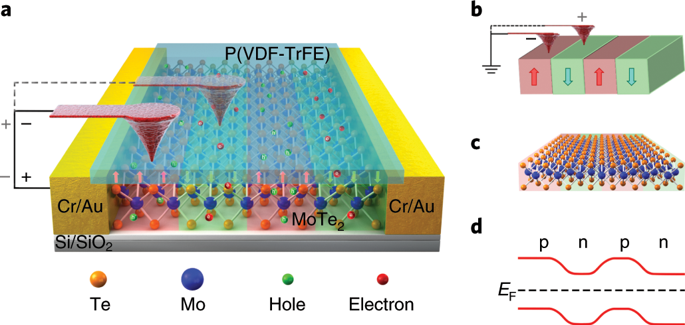Nature Electronics ( IF 33.7 ) Pub Date : 2020-01-24 , DOI: 10.1038/s41928-019-0350-y Guangjian Wu , Bobo Tian , Lan Liu , Wei Lv , Shuang Wu , Xudong Wang , Yan Chen , Jingyu Li , Zhen Wang , Shuaiqin Wu , Hong Shen , Tie Lin , Peng Zhou , Qi Liu , Chungang Duan , Shantao Zhang , Xiangjian Meng , Shiwei Wu , Weida Hu , Xinran Wang , Junhao Chu , Jianlu Wang

|
Semiconductor devices based on two-dimensional (2D) transition metal dichalcogenides could help overcome the scaling limits of silicon complementary metal–oxide–semiconductor (CMOS) technology. However, the development of atomically thin devices requires approaches to control the carrier type in 2D semiconductors. Here, we show that a scanning probe can be used to control the polarization of ferroelectric polymers deposited on 2D transition metal dichalcogenides in order to define carrier injection and achieve p-type and n-type doping. The approach allows lateral p–n, n–p, n–n and p–p homojunctions to be arbitrarily formed and altered. Molybdenum ditelluride (MoTe2) p–n homojunction devices constructed using this method exhibit high current rectification ratios of 103 and good optoelectronic properties (responsivity of 1.5 A W−1). Unconventional nonvolatile memory devices are also built, such as an electrical writing and optical reading memory device, without the restrictions of physical source, drain or gate electrodes, and a quasi-nonvolatile memory with a refresh time of 100 s and a write/erase speed of 10 µs.
中文翻译:

由非易失性铁电畴控制的可编程过渡金属二硫属化物同质结
基于二维 (2D) 过渡金属二硫化物的半导体器件有助于克服硅互补金属氧化物半导体 (CMOS) 技术的缩放限制。然而,原子级薄器件的开发需要控制二维半导体中载流子类型的方法。在这里,我们展示了扫描探针可用于控制沉积在 2D 过渡金属二硫属化物上的铁电聚合物的极化,以定义载流子注入并实现 p 型和 n 型掺杂。该方法允许任意形成和改变横向 p-n、n-p、n-n 和 p-p 同质结。使用该方法构建的二碲化钼 (MoTe 2 ) p-n 同质结器件表现出 10 3 的高电流整流比和良好的光电特性(1.5 A W -1的响应度)。还构建了非常规的非易失性存储器件,例如电写和光读存储器件,不受物理源极、漏极或栅电极的限制,以及刷新时间为 100 s 和写入/擦除速度的准非易失性存储器10微秒。











































 京公网安备 11010802027423号
京公网安备 11010802027423号